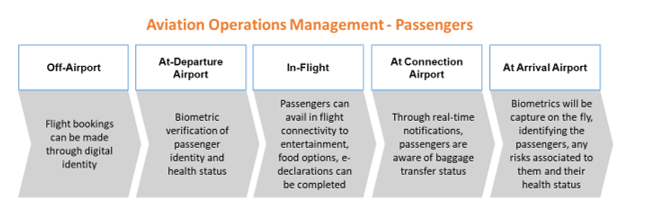Aviation Digital Transformation
Digital transformation is the process of using digital technologies to create or modify existing business processes and customer experiences to meet evolving business and market requirements. It uses digital data to simplify the work and how value is delivered to customers. Digital transformation has led organisations to move their business operations from handwritten ledgers, physical documents, and faxes to digital formats. Their marketing strategies have moved from print mail campaigns, billboard adverting to email campaigns and social media marketing. Businesses leverage BIG Data, employing Artificial Intelligence to identify their audience and the best method to advertise, and to improve their business operations efficiency. It touches every aspect of customer service and business operations, with a wide range of applications in the aviation industry
Drivers of Aviation digital transformation
Intense competition among market players in the aviation Industry-According to IATA (International Air Transport Association), nearly 1300 new airlines were introduced in the last 40 years, leading to cost-based competition. Airlines make efforts to differentiate services for the passengers. Personalized digital services are one-way airlines differentiate themselves from other competitors. It is expected for the usage of digital technologies to increase at a high rate
Rise in passenger traffic in developing countries– Passenger traffic in countries such as India, China, and Indonesia, is increasing due to the increased standard of living and increased disposable income
Market trends associated to the digital transformation in Aviation industry
Air Traffic Management Market – Growth of this market is attributed to modernization of air traffic management infrastructure and the need for airspace management. It is expected to be worth 17.6 USD billion by 2025 from 9.7 USD billion in 2020 with a CAGR of 12.6%
Weather Forecasting Market– Growth of this market is attributed to increased demand for weather monitoring and forecasting systems. Technological advancement such as dual polarized radar and advanced weather satellite technologies drive the market. It is expected to be worth 3.5 USD billion by 2026 from 2.7 USD billion in 2020 with a CAGR of 5.1%

Role of Aviation digital transformation
Digitalization of flight– A range of software and services provide benefits to airlines in everyday flight operations. Work operations in flights have become more computerized, a networked ecosystem of apps, services, and documents defines the future of the flight deck. Pilots acquire rich, important information from a single handheld device. Pilots have access to more economical flight paths, weather data
Digitization helps airlines run more efficiently– Application-rich cockpit and cabin crew tablets to accessible flight deck connection channels can enable constant data sharing with the ground and evolving digital applications that can communicate with people on-board
Customer Experience– Two major challenges faced by airline sectors are changing customer behaviour and growing global competition. By adapting social media channels, the cloud and mobile technology, airlines could address these challenges. Quality assurance and testing are crucial in ensuring that online transactions are a good customer experience, as more people book tickets online from apps or airline websites
Aviation Operations management– Airlines with the help of AI-based techniques can develop air traffic systems. They can forecast future expected air traffic and also predict the weather, allowing airlines to provide enhanced quality, efficiency, and air transportation
Conclusion
Adoption of digital technologies in aviation brings operational efficiency and reduced costs associated with the operations and has transformed customer service. It assists airlines to keep up with the changing demands of consumers and provide differentiated offerings to compete with the intense competition in the industry. Overall investment in the sector is going to rise due to increased air traffic in the forecasted future. It enhances the overall experience of the consumer, expedites the tedious wait times, and provides better data and communication tools for pilots and crew members.
A few challenges faced by consumers are related to website security, and operational difficulties associated with digital technologies in aviation need to be addressed as well. However, the implementation and growth of the digital technologies are positive.
For more detail Contact:
UnivDatos Market Insights
C80B, Sector-8, Noida,
Uttar Pradesh 201301
For Sales related query, please reach us at[email protected]
